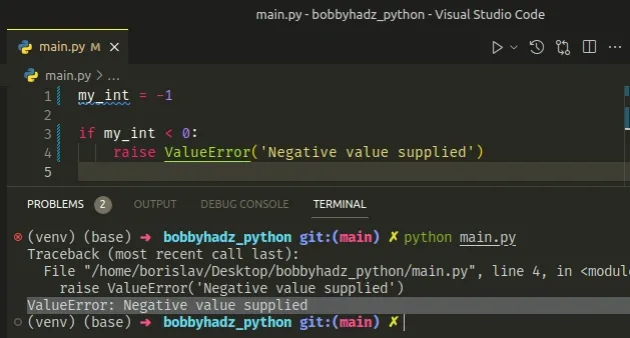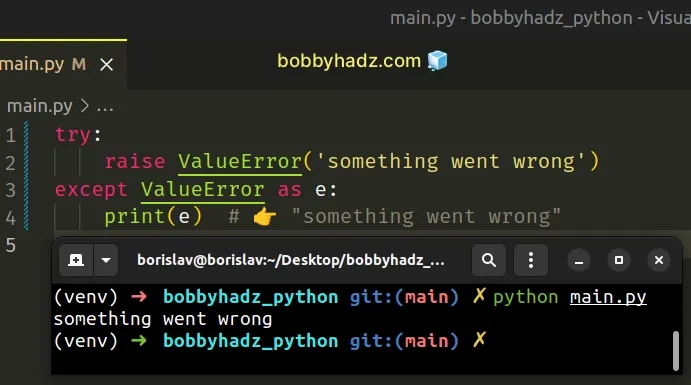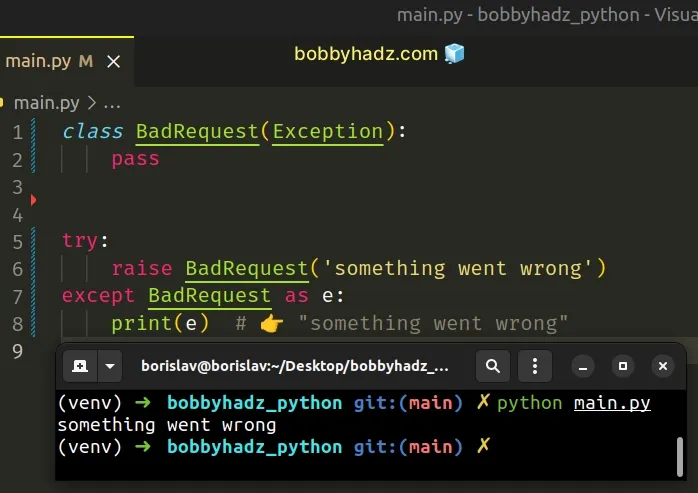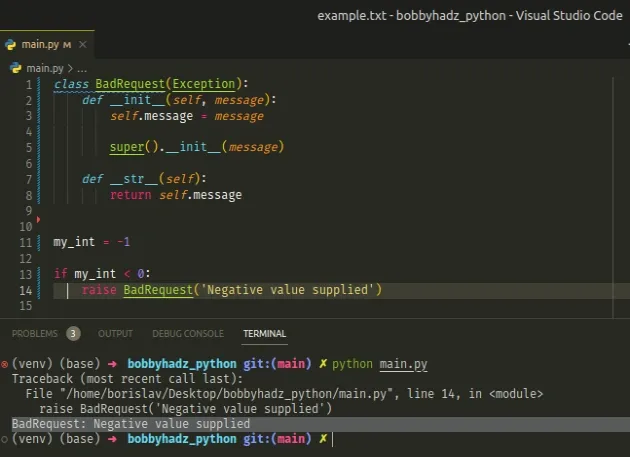TypeError: exceptions must derive from BaseException [Fixed]
Last updated: Apr 8, 2024
Reading time·3 min

# TypeError: exceptions must derive from BaseException
The Python "TypeError: exceptions must derive from BaseException" occurs when
we raise an exception that is not an instance of a class that inherits from the
built-in Exception class.
To solve the error, use a built-in error class, e.g.
raise ValueError('message') or define your own.

Here is an example of how the error occurs.
# ⛔️ TypeError: exceptions must derive from BaseException value = 'bobbyhadz.com' if not isinstance(value, bool): raise 'Expected a boolean value'
We used a raise statement with a string which caused the error.
Exceptions must be classes or instances created from classes that inherit from
the Exception class.
# Instantiate a built-in class to raise an Error
You can instantiate a built-in class like ValueError to raise an error.
my_int = -1 if my_int < 0: raise ValueError('Negative value supplied')

You can also handle the exception by using a try/except statement.
try: raise ValueError('something went wrong.') except ValueError as e: print(e) # 👉️ "something went wrong"

The try block raises a ValueError exception which is then handled by the
except block.
If you don't handle the exception using a try/except statement, the Python
interpreter exits and the program stops running.
The example uses the ValueError class, however, other common exception classes
are TypeError, StopIteration, ReferenceError, etc.
You can view all of the available exception classes in this section of the docs.
# Defining a custom exception class
There are many different
Base classes
you can use, but you can also define your own by inheriting from the built-in
Exception class.
class BadRequest(Exception): pass try: raise BadRequest('something went wrong.') except BadRequest as e: print(e) # 👉️ "something went wrong"

Notice that we can handle the custom error in the except block.
All built-in, non-system-exiting exceptions are derived from the Exception class and it should also be used for user-defined exceptions.
Here is a very simple implementation of a custom exception class.
class BadRequest(Exception): def __init__(self, message): self.message = message super().__init__(message) def __str__(self): return self.message my_int = -1 if my_int < 0: raise BadRequest('Negative value supplied')

The if statement checks if the integer is less than 1 and raises a
BadRequest exception if the condition is met.
# The hierarchy of the built-in Exception classes in Python
All of the built-in exception classes are a subclass of BaseException.
As the error message states: "TypeError: exceptions must derive from BaseException".
The Exception class is a subclass of the BaseException class.
As the
documentation states,
all user-defined exceptions should be derived from the Exception class.
The Exception class is the base class of all non-fatal exceptions.
Exceptions that are not subclasses of Exception are considered fatal because
they are typically not handled.
These exceptions are used to terminate the program.
Examples of fatal exceptions include sys.exit() and KeyBoardInterrupt which
is raised when the user chooses to interrupt the program.
In other words, all non-fatal exception classes should extend from Exception
and not from BaseException.
If you don't handle an exception using a try/except statement, the program
stops and the Python interpreter exits.
raise ValueError('Something went wrong.') print('this never runs')
The print() statement in the example is never reached.
You can use a try/except statement if you need to handle an exception, so the
program continues to run.
try: raise ValueError('Something went wrong.') except ValueError as e: print(e) # 👉️ Something went wrong print('this runs ✅')
The try block raises a ValueError exception which is then handled by the
except block.
The program continues to run and the print() function prints the message.
Check out the built-in base classes before defining your own exceptions.
They cover many different errors, and you might not have to define your own.
# Additional Resources
You can learn more about the related topics by checking out the following tutorials:
- KeyError: 0 exception in Python [Solved]
- Using try without except (ignoring exceptions) in Python
- Call a class method from another Class in Python
- Purpose of 'return self' from a class method in Python
- Convert a string to a Class object in Python
- Creating class instances from a Dictionary in Python
- How to Create an incremental ID in a Class in Python
- How to get the File path of a Class in Python
- Consider explicitly re-raising using 'raise Error from'
- How to keep a Python script output Window open
- Python socket.error: [Errno 104] Connection reset by peer
- Nodename nor servname provided, or not known error [Solved]

